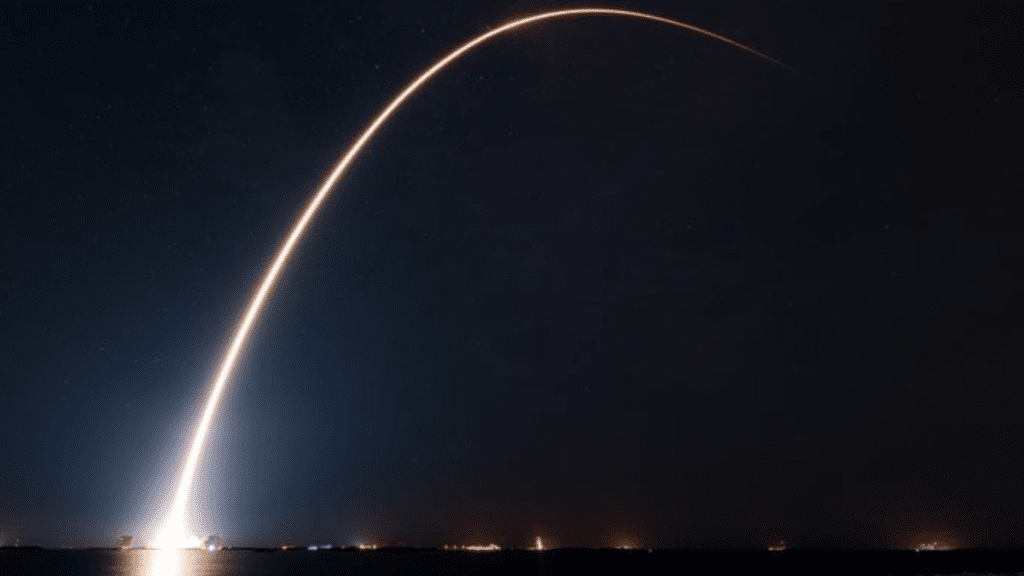 Credit: SpaceX Twitter, @SpaceX
Credit: SpaceX Twitter, @SpaceX SpaceX achieved a major milestone with its 16th Falcon 9 rocket launch, setting a new record for rocket reuse, while also announcing plans to extend the lifespan of its boosters.
- The Falcon 9’s first-stage booster carried 22 Starlink “V2 Mini” satellites into Earth’s lower orbit.
- The booster landed safely on the SpaceX drone ship “Just Read the Instructions” in the Atlantic Ocean, about 8.5 minutes after liftoff.
- SpaceX aims to extend the lifespan of its Falcon 9 boosters, planning to fly them up to 20 times, doubling the original goal of 10 flights per booster.
On July 10 (03:58 GMT), in a major milestone, SpaceX was successful in its 16th SpaceX Falcon 9 rocket launch, setting a new record for rocket reuse. Approximately 8.5 minutes after liftoff, the booster successfully landed on the SpaceX drone ship “Just Read the Instructions” (JRTI) in the Atlantic Ocean.
The unprecedented 16th launch for the Falcon 9’s first-stage booster made it the most flown booster in SpaceX’s history.
The rocket lifted off from Cape Canaveral Space Force Station in Florida, carrying 22 of SpaceX’s Starlink “V2 Mini” satellites to low-Earth orbit. It deployed the satellites into orbit about 62 minutes after launch. These V2 Minis feature advanced technologies, including more powerful phased-array antennas and the use of E-band for backhaul, enabling them to provide approximately four times more capacity per satellite than earlier versions.
The Falcon 9 booster used in the 16th SpaceX Falcon 9 rocket launch previously flew in December 2022 and has an impressive flight history, surpassing the company’s original goal of 10 flights per booster. Among its 15 previous flights are the Demo-2 mission, SpaceX’s first crewed mission, which transported NASA astronauts to the International Space Station in 2020. This successful launch and landing demonstrate the continued viability of reusable rocket technology and pave the way for even more ambitious plans, such as SpaceX’s next-generation Starship vehicle, which aims for full reusability.
Following the 16th SpaceX Falcon 9 rocket launch, Musk’s aerospace company announced its plan to extend the lifespan of its reusable Falcon 9 boosters. SpaceX now aims to fly its boosters up to 20 times, doubling the initial target. This achievement comes after a meticulous process of inspections and refurbishment, including recertification, to ensure the boosters’ ability to fly multiple additional missions.
The Falcon 9 rocket, with its reusable first stage and payload fairing, has significantly reduced launch costs, estimated to be less than $30 million per flight. With the boosters still in good condition after each flight, SpaceX gained confidence in extending their lifetimes.
The company’s Block 5 version of the Falcon 9, introduced in 2018, was initially designed for 10 flights but later extended to 15. Engineers performed rigorous testing, including vibration testing beyond 15 flights, to demonstrate the boosters’ durability.
Considering that this is the 16th SpaceX Falcon 9 rocket launch, the rocket’s reliability and reusability have made it a workhorse for the company, allowing for an accelerated launch cadence while maintaining cost efficiency. As SpaceX continues to push the boundaries of rocket reuse, attention is now turning to the Falcon Heavy and the upcoming launch of the Jupiter-3 Ultra-High-Density Satellite, set to further expand SpaceX’s capabilities and achievements.
Inside Telecom provides you with an extensive list of content covering all aspects of the tech industry. Keep an eye on our Tech sections to stay informed and up-to-date with our daily articles.